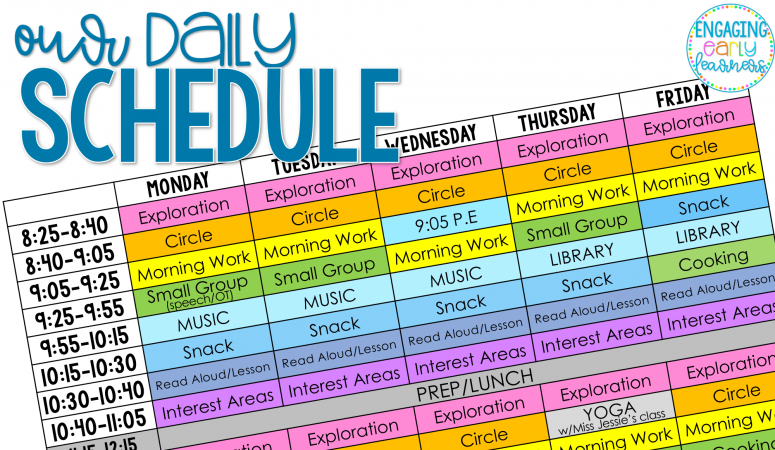Hi everyone,
Welcome to my blog! I am so glad you are here to read my very first blog post!! In this blog I am going to give you a description of a typical day in my classroom. I start by giving you some general information about my class so that you have an understanding of who is in it, and then I go into detail about each part of my day. I also let you know what my role and my teaching assistant’s roles are during each part of the day. I hope this helps you in your classroom!!
I will be giving an extensive classroom tour in my Instagram (EngagingEarlyLearners) stories at the end of August so please watch that so you can SEE everything I discuss here. That tour will be saved to my story highlights as well!
If you have any questions, please feel free to email me: [email protected]
–
MY CLASS-General Info
I teach a preschool self-contained class in a public school. I have 2 half day classes that can go up to 12 students in each, and two teaching assistants. My AM class goes from 8:25am-11:15am and my PM class goes from 12:15pm-2:55pm. All of my students have IEPs (Individualized Education Plans). In my school there are also two other preschool classes. One class utilizes ABA (Applied Behavior Analysis) where students work in 1:1 and 1:2 ratios with teachers. The other class is an integrated class, where half of the students are typically developing, and the other half of the students have special needs. Having the different classes allows us to move students to the class that best fits their needs at any time during the school year. Also, if we find it appropriate, we have the ability to have a student split their day between two classes.

You can find this schedule template and MORE in my FREE RESOURCE LIBRARY!
Transitions
I wanted to explain how I handle transitions in my classroom before I get started. I have a wireless doorbell from Amazon that is probably the best thing I ever bought for my classroom. I use it for every single transition, including switching interest areas. I teach my students in the beginning of the year to freeze and look at me when the bell goes off. This definitely takes some practice. So, when the bell goes off I say, “Hands up, freeze, and look at me”. This allows all of the students to concentrate on the directions before moving. With that being said, I also give my students a lot of warnings before transitions. I know this helps all students, but especially in a special education class it is important that your students are prepared for what is coming next, and WHEN it is coming. For this I normally just announce that there are __ minutes left before __. I also make sure to go up to specific students, who I know struggle with transitions, and let them know that a transition is coming.
UNPACK
My students come off the bus from the door next to my classroom. They are able to walk right into my classroom and start unpacking. I have an unpacking visual schedule posted next to each cubby. Although most of my students are able to unpack independently, I found that having the visual there helps them stay on task. I mean, we all need visuals…right?! During unpacking my students hang up their jackets and backpacks, put their folder in the bin and put their snack in the top cubby.

EXPLORATION (Independent Task Box Work Station)
After my students unpack their backpacks, they get on line to pick their first independent activity from their assigned drawer. Students complete their activity and then get a new one. They continue this until the bell goes off. We use a wireless doorbell in my classroom!
See my blog post on Especially Education’s blog for more information on my independent task box work station. Here I go into much further detail on this… https://especiallyeducation.com/task-box-independent-work-system/

CIRCLE TIME
My students sit on our large carpet for circle time. I use the SmartBoard to display what we need; weather, calendar, etc. This is when we discuss the day. Our greeter says “hello” to all the students and teachers, we talk about our jobs, discuss who is at school that day, discuss the calendar, schedule for the day, and the weather. These routines help foster math concept understanding, as well as social skills and language. My teaching assistants sit behind the students to make sure that everyone is sitting nicely and attending.
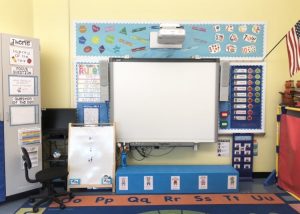
MORNING WORK – Sign In, Seat Work, Table Time
(see my Morning Work story highlight on Instagram for more information about this time)
SIGN IN/SEAT WORK
Students independently sign themselves into class by completing a handwriting task. Every student starts off by tracing lines and circles and gradually moves up to spelling, building and tracing their own name. After sign in they complete a seat work task which is a worksheet specifically targeted to skills like tracing, matching, coloring, etc. These tasks are leveled to meet every student’s needs. My teaching assistants and I each sit at a table during this time to ensure that every student is on task.

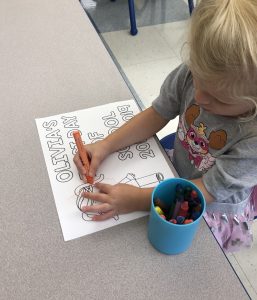
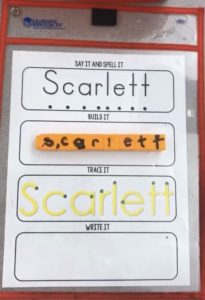
TABLE TIME
Each day the children engage in fine motor, visual motor perception, and readiness activities such as pegboard, beading, Legos, etc. When finished, they clean up their materials and choose a new activity of their choice. My teaching assistants and I allow our students to independently explore their table time activities during this time.
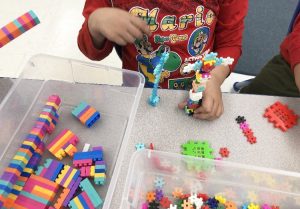
SMALL GROUP
Children circulate through small group activities with the teacher and assistants. Groups are 2-4 children and address mostly academic, motor, and social goals. The groupings of students change from day to day according to the specific goals being addressed for each child. Activities are open-ended allowing for exploration and work on numerous types of skill levels. (example: work with colored bears-addresses counting, sorting, color ID, patterning). On Fridays we always do a cooking activity with another preschool class. Our cooking activity always relates to the season and/or theme.
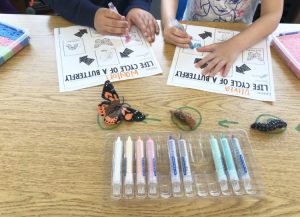

SPECIALS
Each day we have a special area class within our classroom. This includes music and library. We also have gym once or twice a week. Library and music happen within the classroom on our large carpet, which allows for some consistency for my students. During this time my teaching assistants assist the special area teacher by sitting behind the students to make sure they are sitting nicely and attending.
SNACK
Snack time is about 10-15 minutes. I encourage families to only send one snack and a drink because our day is so short, and I want to be able to fit as much in as possible.
READ ALOUD/LESSON
We use the Creative Curriculum in our classroom. During this time I introduce/discuss the theme in detail and the students participate in learning activities and read alouds related to the theme. Since the curriculum is written for a general education full day class, and we are a special education ½ day class, I have the freedom to modify and adapt the curriculum as needed. I basically take the focus question for the week and adapt the content to best fit my population of students. I use TwoPeasInAPrimaryPod’s achor chart materials and I use read alouds from my school library, and sometimes the curriculum, to teach my students about the focus question.
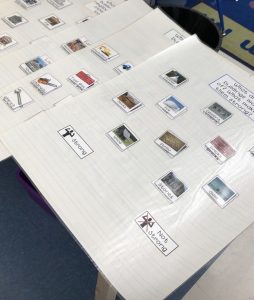
INTEREST AREAS
During this time the students choose among the open interest areas of the day. They have approximately 5-10 minutes in each interest area before the bell (wireless doorbell from Amazon) goes off to switch to another area. Individual students may be pulled at this time for more extensive work on IEP and classroom goals. The teaching assistants and I circulate during this time to assist in play, socialization, and language.
Our interest areas include: Pretend Play, Art, Building, Cars &Trucks, Puzzles, Sensory Table, Magnet Board, Books, Play Dough, Fine Motor
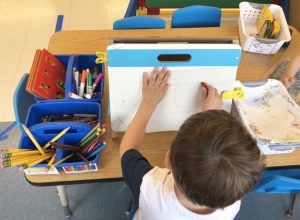
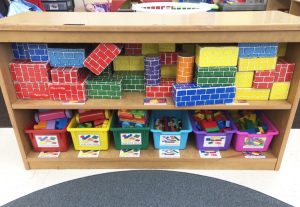
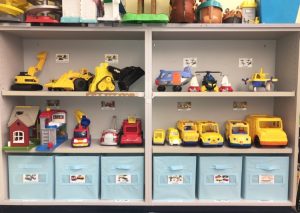
PACK UP
After we clean up interest areas all of my students sit on the carpet for songs. During songs I call 2-3 students over to their cubbies at a time. This past year I learned that this works SO much better than having everyone pack up at once! I also have a visual for packing up posted next to each cubby. My teaching assistants switch the unpacking visual schedule to the packing up one during the day. Having the visual has really helped my students with packing up. I always found that they had trouble getting everything into their backpacks, but if they go in order of the schedule (folder in first) than they do not have trouble.

–
Thanks for reading all the way to the end!
As a thank you, here is a completely editable version of my classroom schedule that I used in my classroom.
If you have any questions, please feel free to email me: [email protected]

